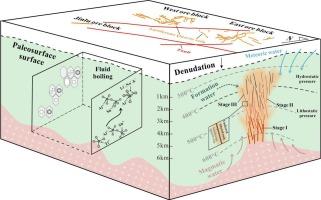Ore genesis of the Jinchanggouliang Au deposit in the northern North China Craton: Constraints from vein quartz and fluid inclusions
IF 3.6
2区 地球科学
Q1 GEOLOGY
引用次数: 0
Abstract
The Jinchanggouliang gold deposit, containing exceeding 40 tons Au, is a quintessential large-scale deposit formed during the Yanshanian mineralization period in the northern margin of the North China Craton. However, previous studies have been highly controversial regarding the properties and evolution of ore-forming fluids, as well as the ore-forming conditions. This study employs H-O isotope analysis, fluid inclusion petrographic observation and microthermometry, in-situ LA-ICP-MS analysis of quartz and individual fluid inclusions to constrain the origin and properties of the ore-forming fluid, the fluid evolution process, and the Au precipitation mechanism. The mineralization process at Jinchanggouliang is divided into three stages: milky quartz (Q1, stage I), quartz (Q2) + pyrite (stage II), quartz (Q3) + polymetallic sulfides (stage III). Stage III represents the principal mineralizing phase within the paragenetic sequence of the hydrothermal system. The primary fluid inclusion types are divided into three categories: two-phase aqueous inclusions (type I), two-phase CO2-bearing aqueous inclusions (type II), and three-phase solid-bearing inclusions (type III). Microthermometry results indicate that the homogenization temperature progressively decreases from stage I to stage III, with significant salinity fluctuations. The ore-forming fluid is categorized within the H2O-NaCl system, displaying features indicative of high-temperature conditions and a variable salinity range (1.7–37.8 wt% NaCl equiv.). Fluid boiling occurs at stage III. In-situ LA-ICP-MS analysis of fluid inclusions, combined with stable H-O isotope studies of quartz, delineates that the fluid is primarily sourced from magmatic water, with a contribution of meteoric water during the main metallogenic stage. The Rb/Cs ratio of fluid inclusions remains relatively stable across all stages, with values oscillating within a narrow range of 1–10, indicating a single source for the fluid system. As the progression from the stage I to III, the Ti content in quartz gradually decreases, while the Al and Sb contents increase. The correlation between Al and Li, as well as between Al and the sum of Li, Na and K, gradually increases, indicating a transition from single substitution to compensated substitution in quartz from the pre-ore to the main-ore stage. The formation conditions of quartz in each stage, calculated using TitaniQ, and fluid inclusion P-T formulas, are approximately 1.43 kbar at 548 °C for stage I, 0.73 kbar at 441 °C for stage II, and 0.14 kbar at 341 °C for stage III. As the fluid progressed towards the main mineralization stage, the lithostatic pressure transitioned to hydrostatic pressure. Fluid boiling in stage III is attributed to rapid pressure reduction. The escape of acidic volatiles and the addition of meteoric water gradually increase the pH. These physicochemical perturbations triggered extensive metal precipitation and mineralization, including Au. According to the experimental data and ore body occurrence, Jinchanggouliang gold deposit should be classified as the magmatic-hydrothermal vein type, which have a certain prospecting potential for porphyry and epithermal mineralization.

华北克拉通北部金厂沟梁金矿床矿床成因:脉状石英和流体包裹体的制约
金厂沟梁金矿床是华北克拉通北缘燕山期成矿期典型的大型金矿床,含金量超过40吨。然而,前人对成矿流体的性质、演化及成矿条件的研究存在很大争议。通过H-O同位素分析、流体包裹体岩相学观察和显微测温、石英和单个流体包裹体原位LA-ICP-MS分析,对成矿流体的来源、性质、流体演化过程和Au的沉淀机制进行了约束。金长沟梁成矿过程分为3个阶段:乳白色石英(Q1阶段)、石英(Q2阶段)+黄铁矿(II阶段)、石英(Q3阶段)+多金属硫化物(III阶段)。第三阶段是热液系统共生序列中的主要矿化阶段。原生流体包裹体类型分为三类:两相含水包裹体(ⅰ型)、两相含二氧化碳包裹体(ⅱ型)和三相含固包裹体(ⅲ型)。显微测温结果表明,从第一阶段到第三阶段,均一温度逐渐降低,盐度波动明显。成矿流体属于H2O-NaCl体系,具有高温条件和可变盐度范围(1.7-37.8 wt% NaCl当量)的特征。流体沸腾发生在阶段III。流体包裹体原位LA-ICP-MS分析结合石英稳定H-O同位素研究表明,流体主要来源于岩浆水,主要成矿阶段有大气水的贡献。流体包裹体的Rb/Cs比值在各个阶段保持相对稳定,在1 ~ 10的狭窄范围内振荡,表明流体体系为单一来源。随着第I阶段到第III阶段的进行,石英中Ti含量逐渐降低,而Al和Sb含量逐渐增加。Al与Li的相关性以及Al与Li、Na、K的总和的相关性逐渐增强,表明石英从前矿阶段到主矿阶段由单一取代向补偿取代过渡。利用TitaniQ和流体包裹体P-T公式计算,石英在每个阶段的形成条件约为1.43 kbar(548°C),第I阶段为0.73 kbar(441°C),第III阶段为0.14 kbar(341°C)。随着流体向主成矿阶段推进,静岩压力向静水压力过渡。第三阶段的流体沸腾归因于压力的迅速降低。酸性挥发物的逸出和大气水的加入使ph值逐渐升高。这些物理化学扰动引发了广泛的金属沉淀和矿化,包括金。根据实验资料和矿体赋存状态,认为金厂沟梁金矿床属岩浆-热液脉型金矿床,具有一定的斑岩及浅成热液成矿潜力。
本文章由计算机程序翻译,如有差异,请以英文原文为准。
求助全文
约1分钟内获得全文
求助全文
来源期刊

Ore Geology Reviews
地学-地质学
CiteScore
6.50
自引率
27.30%
发文量
546
审稿时长
22.9 weeks
期刊介绍:
Ore Geology Reviews aims to familiarize all earth scientists with recent advances in a number of interconnected disciplines related to the study of, and search for, ore deposits. The reviews range from brief to longer contributions, but the journal preferentially publishes manuscripts that fill the niche between the commonly shorter journal articles and the comprehensive book coverages, and thus has a special appeal to many authors and readers.
 求助内容:
求助内容: 应助结果提醒方式:
应助结果提醒方式:


